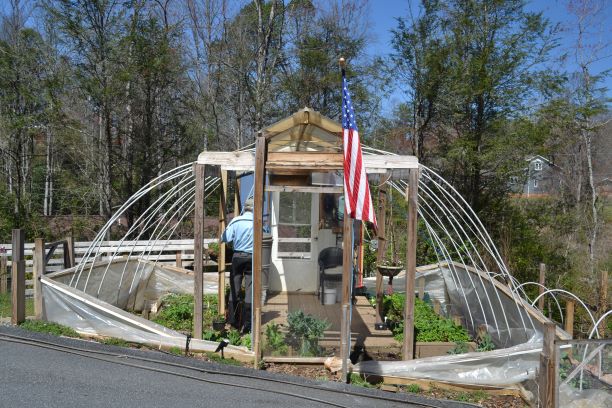The story was originally published in The Sylva Herald on April 1
Story co-written with Lili Stapel

Transformer greenhouses invented by Bob Houghton, a retired Western Carolina University professor and former elementary school teacher, are more affordable than standard greenhouses and make all-year-round gardening an easily attainable goal.
In Houghton’s new book, “Transformer Greenhouses: Multi-season Food for All,” he walks through the benefits of having a greenhouse, the process of building a transformer greenhouse and tips to care for it.
“What makes transformer greenhouses so unique is they don’t have a fixed roof, unlike standard greenhouses,” he said.
A transformer greenhouse has a wooden frame about the size of a small hallway in the middle with a small roof over it and curved ribs on its sides. The covering for these ribs and what seals the greenhouse is a plastic cover that attaches to a rope pulley system and hand winches. This cover can easily open and close the greenhouse like a clam shell to adjust to different weather conditions.
Most of the materials to build these greenhouses can be found in local hardware stores, and with proper preparation, can take only a day or two to build, Houghton said.
“I would say two carpenters would put one of these up in a day,” he said. “There is very little to the carpentry work involved. It’s simple.”
Transformer greenhouses offer many benefits compared to standard ones, Houghton said.
Most notably, they are a fraction of the price.
A standard 12-foot by 18-foot greenhouse, like the ones at the Cullowhee Community Garden, cost around $13,000 to build, while a transformer greenhouse the same size costs only $800, he said. Houghton attributes the price difference to simplistic design and his goal to make it as inexpensive as possible.
Houghton’s greenhouses also cost less in long-term maintenance, he said.
For example, the cover can be opened to release heat and allow rain in, which reduces ventilation and water costs.
Houghton has three different designs for the transformer greenhouses, and currently has one of each on his property:
Design 1, “Blueberry Hill Deck Greenhouse,” is a 16-foot by 20-foot double-sided greenhouse that covers an 8-foot by 12-foot deck at its center. This deck can be used to eat dinner, read a book or simply enjoy the plant life.
Design 2, “Southside Greenhouse,” is a 29-foot-long single sided greenhouse. Houghton has this greenhouse attached to the back of his house, serving as a home for his vegetables.
Design 3, “Circle Drive Greenhouse,” is a 24-foot-long double-sided greenhouse. This design is very similar to Design 1, only slightly bigger and without the deck inside.
Building a greenhouse was easy for Houghton, but inventing and refining were much more challenging.
“When you are inventing greenhouses while you are building them, you kind of get part of it done and then you redesign it while you are sleeping at night,” Houghton said. “Then you get up in the morning and do something else and then you take it down and rebuild it.”
Building his first greenhouse in 2001, Houghton originally used it as a teaching aid, inviting students to his house and providing tours to better their understanding of the materials they were learning.
“What I was looking for at the time was a way for my elementary and middle grade students to think about getting real world data to do math and science in their classrooms,” he said.
Houghton’s book is available for purchase at City Lights Bookstore in downtown Sylva.


